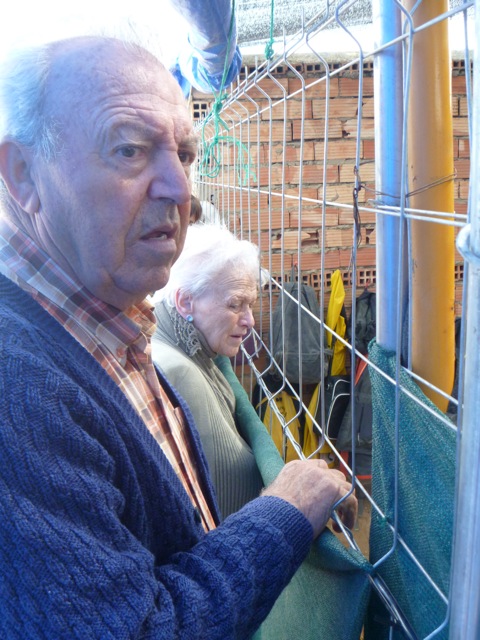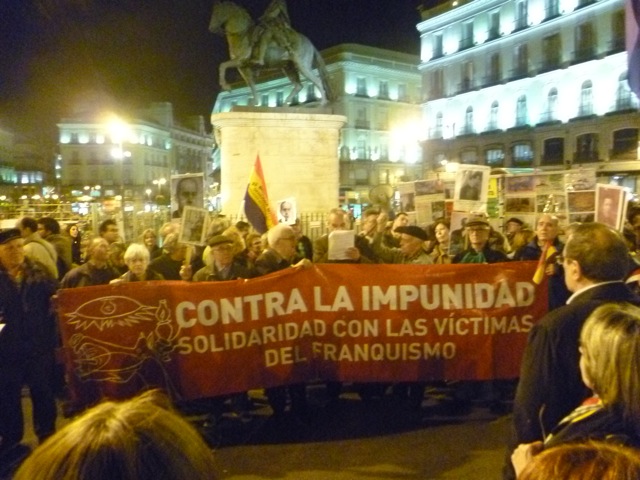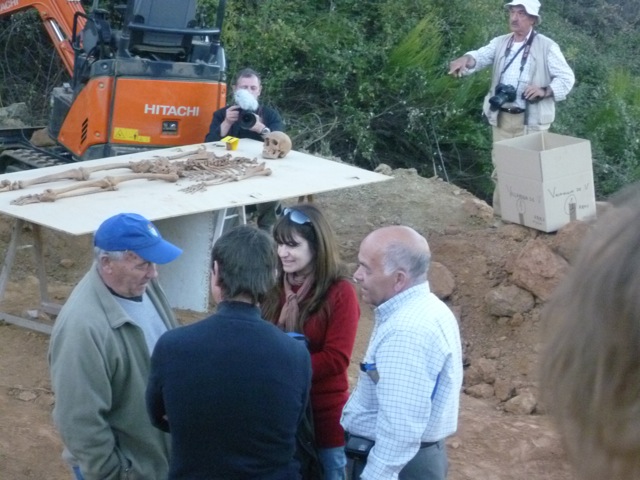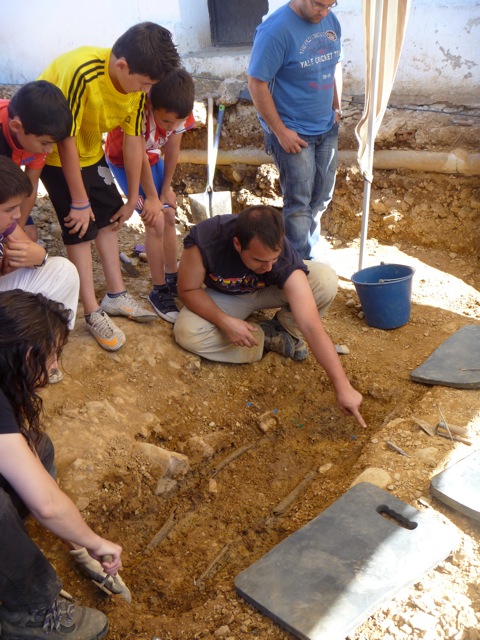Interview: Jonah S. Rubin and “Re-membering the Spanish Civil War”
Jonah S. Rubin is a Ph.D. student in anthropology at the University of Chicago. In 2010 he received a Dissertation Fieldwork Grant to aid research on ‘Re-membering the Spanish Civil War: Thanatopolitics and the Making of Modern Citizens in Spain,’ supervised by Dr. Jean Comaroff. We reached out to Jonah to learn more about how Spain’s war dead are now being increasingly mobilized in public memory and civic education.

There have been many scholarly studies of the (re)formation of historical memory in the wake of repressive regimes, in places like Latin America, the former Soviet bloc and South Africa, to name a few. What makes the Spanish case stand out as unique or noteworthy to you?
When Spain underwent its transition from the Franco dictatorship to democracy in the late 1970s, contemporary democratic theory emphasized the need to “forget” a divisive past in order to build a common future together. Therefore, Spain undertook a tacit “Pact of Oblivion,” in which the various political and media elite agreed not to debate, discuss, or litigate the crimes of the fascist state. This means that in a very real sense, the successes of the Spanish transition to democracy depended upon the continuation of the violence of the fascist state against the families of Republicans and civilians who were murdered by the Franco regime. While many in the Spanish political elite continue to cling to the pacts of the transition, since the year 2000 families of victims and the NGOs they have formed have sought to import the sorts of forensic, documentary, and historical practices that have been developed in subsequent transitional justice processes, most notably those of Latin America, but also those developed in South Africa, Rwanada, and the former-Yugoslavia. Unfortunately, these efforts remain almost entirely funded and conducted by civil society organizations, as state aid has been tepid at best.
From an anthropological and broader social scientific perspective, however, this affords a unique opportunity to reexamine some ongoing debates about historical memory in post-conflict societies. Much of the existing literature on forensic practices focuses in on the inevitable conflicts that occur between the often bureaucratic forensic practitioners and the relatives of victims. In Spain, however, the NGOs can be far more flexible and responsive to the needs of family members. While continuing to follow standard forensic practices, these NGOs can afford to be far more flexible and responsive to the needs of families than state- or UN-sponsored efforts that inspired it.
In terms of transitional justice policy, then, while the Spanish model of democratic transition may appear to be anachronistic to most contemporary observers, the innovations of the Spanish memory movements may yet provide insight for governments designing forensic programs around the globe.
This unique situation opens up novel perspectives on certain very basic anthropological questions: What role do the dead play in the construction, circulation and authorization of historical narratives? How do the dead continue to play active roles in liberal democracies like Spain? And how do we explain the compulsion towards forensic evidence – even in the absence of the sorts of juridical forums, such as Truth Commissions or war crimes tribunals, in which such evidence might actually be applied?
You put special emphasis on the role that memory plays in civic education and “forming” new citizens in a liberal democracy. How exactly does this play out in Spain?

This is one area where Europe and the United States seem to differ quite a bit. While in the U.S., history is still widely considered to be an important aspect of civic training, we do not phrase our engagements with the past in terms of memory. In Europe, however, there seems to be a greater concern with actively fostering social memories of the past in order to define national belonging in the present. The most obvious way this manifests itself in continental Europe is through the great investment in Holocaust education, which is no longer just part of the school curricula, but is increasingly being incorporated into naturalization programs for recent immigrants.
In Spain, for many years after the death of Francisco Franco (1975) and the inauguration of the Spanish Constitution (1978), the Spanish Civil War was simply not taught in schools. The subject was simply too divisive to form the sorts of broad-hegemonic narratives of the past that are the subject of elementary and high-school curricula. More recently, the Civil War and Franco dictatorship has begun to find its way into school curricula, but there remains a far greater variation in the ways these subjects are taught than with, for example, the Catholic Monarchs or the (Re)Discovery of the Americas. The two high schools in which I conducted fieldwork – one a private Catholic school taught by a right-leaning educator and the other a public school taught by a left-leaning teacher – feature remarkably different narrations of the civil war.
The NGOs associated with the memory movements recognize the ways education programs both past and current fail to inculcate the sort of horror for the fascist Franco regime that Holocaust education programs do for the Nazi regime. They have responded with a wide variety of initiatives, aimed at educating both youth and adults. Just to give a few examples: the Association for the Recuperation of Historical Memory of Madrid asks college students to try to inhabit the position of a relative of a victim and write letters to “their” disappeared love ones. The Forums for Memory leads an annual School of Memory to train new activists in the historical and sociological context of exhumations. And Amical de Mauthausen leads tours of high school students to the Nazi concentration camp in Austria that held Spanish POWs, emphasizing the direct links between Hitler, Mussolini, and Franco. Even the forensic exhumation is structured in large part as a pedagogical intervention: forensic experts will frequently explain the open grave to both present and mass-mediated audiences, weaving together physical-anthropological data, oral and documentary historical information, and moral claims.
All of these education efforts must struggle to strike the right balance between broadly humanistic tones that emphasize the universal right to a dignified burial and the more political claims of the special importance of honoring those killed by fascists for defending the Second Republic. In so doing, the individuals and groups of the memory movement are implicitly, and quite often explicitly, developing a critical sociology of the Spanish pubic, a definition of citizenship that includes certain engagements with the past, and a theory of both how memory works and why it is valuable.
A component of your research concerns the coordinated exhumations of civil war victims by NGOs, and you actually witnessed several of these exhumations, including living for a time in a village where one took place. What were some things that struck you about that experience, and witnessing that process?
On a very personal level, I was struck by the level of engagement and dedication of the volunteers of groups like ARANZADI, the Association for the Recuperation of Historical Memory, and the Statewide Federation of Forums for Memory. The levels of engagement between the families and the activists of the memory movements is truly impressive. The forensics go to great length to make sure that the “protagonists” of the exhumations, as they refer to the victims’ relatives, are kept informed of the exhumation’s progress from the investigation phase through the actual digging and onto the identification. In the process, the exhumation manages to create the sorts of spaces in which families and their supporters can meet, gather, and discuss topics which are still taboo in many small villages throughout Spain.

As time went on, I became incorporated into the practice of exhumations. When few people were visiting the site, I could go in and help in the excavation. More often, I could serve as a communicator, explaining the site to visitors while gathering information about the victims which were useful not only to my academic project, but also to the ethical and historical project of the Spanish memory movements.
What was the biggest challenge that you encountered during your fieldwork, and how did you overcome it?
The biggest academic problem I faced probably lay in the design of the project. The Spanish memory movements are an incredibly diverse group of Spaniards, cross-cutting generational and regional lines. The vast majority of those affiliated with the memory movements are volunteers who participate in various civil society groups once or twice a week. Thus, while I encountered a fieldsite in which all of my informants identified as part of this memory community, it was not a community comprised by geographic proximity, as much classical anthropological writing encountered, nor even of communities of practice that many modern anthropologists of politics or religion examine. Depending on the day, I may be at an exhumation on the with one group, at a lecture by another, continue working in an office with a third, visiting an archive on behalf of a fourth, or attending a protest with yet another distinct group. These groups only rarely cross paths in the occasional conference, joint protest, or virtual Facebook group. Designing a methodology adequate to this site required thinking through the memory movements as a loose network of actors organized around a common project, namely the promotion of the memory of Franco’s victims. Trying to come to understand common themes, beliefs, and practices in such a diverse and fractured field – which for all of its multiplicity nonetheless retains coherence for my informants – was probably the biggest challenge I faced in the field.
The continuing importance of the dead in a modern nation-state is a concept that might strike some non-anthropologists as a bizarre or outmoded one. Taking a broad view, what can studying “thanatopolitics” help us to understand about our own lives and experience with politics?

The lack of attention to the role of the dead in modern nation-states – both within he academe and in the broader public sphere – is truly remarkable, especially given how central “those no longer with us” are to many of our most pressing concerns. Just recently, the New York Times featured a front-page story on the controversies over adequately representing the dead, including questions of whether and how to treat their remains, in the forthcoming September 11th museum. And we are all familiar with the now ubiquitous calls for justice on behalf of murder victims. The situation is much the same further afield: Let us not forget that the Arab Spring began when a young Tunisian named Mohamed Bouazizi self-immolated in protest of police corruption. Who would deny that Mr. Bouazizi’s subsequent death played an important role in one of the most defining social movements of our time?
From naming everything form laws to monuments to distinguishing between the grievable and non-grievable life, and from national pantheons of heroes to those whose death demands that we wage war or pass harsh punitive laws, the dead seem to be omnipresent. Anthropologists, of course, have long studied the ways the ways ancestor worship, burial ceremonies, and duendes (spirits) are central to non-Western societies. I suggest that liberal democratic societies may not be as different from these places as we have been led to believe.
To be sure, the oft-stated objection that the dead must always be mediated through the living to realize their effects and are therefore subject to manipulation and distortion is certainly true. But it is no less true of any living citizen, whose capacity for action is no less dependent upon their families, co-workers, political representatives, and myriad other actors. Dismissing the dead as mere projections of the living, as some are wont to do, is not faithful to the empirical record. The agency of the dead may indeed be quite different than that of the living, but recognizing that the dead continue to play a role in the political and socio-cultural lives of the living is necessary if we are to understand the sorts of practices, beliefs, dispositions, and institutions that mark liberal democratic societies.